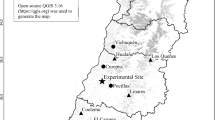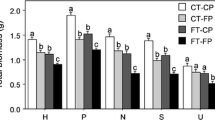Abstract
Determining the adaptability to abiotic conditions and potential establishment success of tree species needs to be conducted before attempting to use a species in large-scale afforestation programs. In this study, the chemical and physiological performance of four Turkish red pine (Pinus brutia Ten.) provenances was investigated after exposure to artificial cold temperature treatments to determine their adaptability to cold environment for potential use in afforestation programs. Seeds were sown and raised for 24, 28, and 32 weeks and exposed to decreasing temperatures in an artificial freezer. Relative electrolyte leakage, chlorophyll fluorescence, and carbohydrate concentrations were measured to determine the variability between provenances. Results showed that diameter and height growth did not vary with origin for each of the three growth stages measured. Root electrolyte leakage values differed between provenances, confirming that cold stress was effectively causing physiological damages when plants were exposed to temperature at −15 °C and below. The variability observed in the relationship between provenances and cold hardiness responses can be attributed to tree-to-tree variability within provenances and microsites conditions. There was generally no significant difference in chlorophyll fluorescence between provenances, also attributed to low genetic variation between provenances. Carbohydrate concentrations were also very variable and varied significantly among growth stages and provenances. High-altitude provenances had higher soluble carbohydrates concentrations in several cases, suggesting a relationship between altitude, soluble sugars, and cold hardiness. However, these trends were not consistent; therefore, we suggest that such hypotheses be confirmed through more comprehensive further studies.


Similar content being viewed by others
References
Adams GT, Perkins RD (1993) Assessing cold tolerance in Picea using chlorophyll fluorescence. Environ Exp Bot 33:377–382
Adams WW III, Demming-Adams B, Winter K, Schreiber U (1990) The ratio of variable to maximum chlorophyll fluorescence from photosystem II, measured in leaves at ambient temperature and at 77 K, as an indicator of the photon yield of photosynthesis. Planta 180:166–174
Baker NR, Rosenqvist E (2004) Applications of chlorophyll fluorescence can improve crop production strategies: an examination of future possibilities. J Exp Bot 55(403):1607–1621
Bannister P, Neuner G (2001) Frost resistance and the distribution of conifers. New For 30:167–184
Bigras FJ, Dumas D (2005) Root-freezing damage in the containerized nursery: impact on plantation sites—a review. New For 30:167–184
Bigras FJ, Margolis HA (1997) Shoot and root sensitivity of containerized black spruce, white spruce and jack pine seedlings to late fall freezing. New For 13:29–49
Bigras FJ, Ryyppö A, Lindstom A, Stattin E (2001) Cold acclimation and deacclimation of shoots and roots of conifer seedlings. In: Bigras FJ, Colombo SJ (eds) Conifer cold hardiness. Kluwer Academic Publishers, Dordrecht, pp 57–88
Binder WD, Fielder P (1996) Chlorophyll fluorescence as an indicator of frost tolerance in white spruce seedlings from different latitudes. New For 11:207–232
Calmé S, Bigras FJ, Margolis HA, Hébert C (1994) Frost tolerance and bud dormancy of container-grown yellow birch, red oak and sugar maple seedlings. Tree Physiol 14:1313–1325
Cannel MGR, Smith RI (1986) Climatic warming, spring budburst and frost damage on trees. J Appl Ecol 23:177–191
Colombo SJ (1990) Bud dormancy status, frost hardiness. Shoot moisture content and readiness of black spruce container seedlings for frozen storage. J Am Soc Hortic Sci 115(2):302–307
Colombo SJ, Raitanen EM (1991) Frost hardening in white cedar container seedlings exposed to intermittent short days and cold temperatures. For Chron 67:542–544
Colombo SJ, Zhao S, Blumwald E (1995) Frost hardiness gradients in shoots and roots of Picea mariana seedlings. Scand J For Res 10:32–36
Corcuera L, Gil-Pelegrin E, Notivol E (2011) Intraspecific variation in Pinus pinaster PSII photochemical efficiency in response to winter stress and freezing temperatures. PLoS One 6(12):e28772. doi:10.1371/journal.pone.0028772
Coursolle C, Bigras FJ, Margolis HA, Hébert C (1997) Dehardening and second-year growth of white spruce provenances in response to duration of long-night treatments. Can J For Res 27:1168–1175
Dubois M, Gilles KA, Hamilton JK, Rebers PA, Smith F (1956) Colorimetric method for determination of sugars and related substances. Anal Chem 28:350–356
Fisker SE, Rose R, Haase DL (1995) Chlorophyll fluorescence as a measure of cold hardiness and freezing stress in 1 + 1 Douglas-fir seedlings. For Sci 41(3):564–575
Flint HL, Boyce BR, Beattie DJ (1967) Index of injury—a useful expression of freezing injury to plant tissues as determined by the electrolytic method. Can J Plant Sci 47:229–230
Genç M (2004) Principles of silviculture. Published by Suleyman Demirel University, Isparta, issue no 44, 341 pp (in Turkish)
Glerum C (1985) Frost hardiness of coniferous seedlings: principles and applications. In: Duryea ML (ed) Evaluating seedling quality: principles, procedures and predictive abilities of major tests. Forest Research Laboratory, Oregon State University, Corvallis, pp 107–123
Gooch NJ, Nzokou P, Cregg BM (2009) Effect of indoor exposure on the cold hardiness and physiology of containerized Christmas trees. HortTechnology 19(1):72–77
Hänninen H (2006) Climate warming and the risk of frost damage to boreal forest trees: identification of critical ecophysiological traits. Tree Physiol 26:889–898
Hänninen H, Kramer K (2007) A framework for modeling the annual cycle of trees in boreal and temperate regions. Silva Fennica 41(1):167–205
Hänninen H, Beuker E, Johnsen O, Leinonen I, Murray M, Sheppard L, Skrøppa T (2001) Impacts of climate change on cold hardiness of conifers. In: Bigras FJ, Colombo SJ (eds) Conifer cold hardiness. Kluwer Academic Publishers, Dordrecht, pp 305–333
Havis JR (1976) Root hardiness of woody ornamentals. HortScience 11:385–386
Işık K (1986) Altitudinal variation in Pinus brutia Ten.: seed and seedling characteristics. Silvae Genet 35:58–67
Jian JH, Livingston WH (1992) Evaluating percent weight less for measuring root cold hardiness of container-grown black spruce. Phytopathology 82:244
Jones EA, Reed DD, Desanker PV (1994) Ecological implications of projected climate change scenarios in forest ecosystems of central North America. Agric For Meteorol 72:31–46
Kandemir GE, Kaya Z, Temel S, Önde S (2010) Genetic variation in cold hardiness and phenology between and within Turkish red pine (Pinus brutia Ten.) populations: implications for seed transfer. Silvae Genet 59:49–57
Kozlowski TT, Pallardy SC (1997) Physiology of woody plants, 2nd edn. Academic Press, San Diego
Kozlowski TT, Pallardy SC (2002) Acclimation and adaptive responses of woody plants to environmental stresses. Bot Rev 68(2):270–334
Krause GH, Weis E (1991) Chlorophyll fluorescence and photosynthesis: the basics. Annu Rev Plant Physiol Plant Mol Biol 42:313–349
Lindström A, Nyström C (1987) Seasonal variation in root hardiness of container-grown Scots pine, Norway spruce and lodgepole pine seedlings. Can J For Res 17:787–793
McKay HM (1992) Electrolyte leakage from fine roots of conifer seedlings: a rapid index for plant viability following cold storage. Can J For Res 22:1371–1377
McKay HM (1994) Frost hardiness and cold-storage tolerance of the root system of Picea sitchensis, Pseudotsuga menziesii, Larix kaempferi and Pinus sylvestris bare-root seedlings. Scand J For Res 9:203–213
Mohammed GH, Binder WD, Gillies SL (1995) Chlorophyll fluorescence: a review of its practical forestry applications and instrumentation. Scand J For Res 10:383–410
Mohammed GH, Noland TL, Parker WC, Wagner RG (1997) Pre-planting physiological stress assessment to forecast field growth performance of jack pine and black spruce. For Ecol Manag 92:107–117
Morin X, Ameglio T, Ahas R, Kurz-Besson C, Lanta V, Lebourgeois F, Migletta F, Chuine I (2007) Variation in cold hardiness and carbohydrate concentration from dormancy induction to bud burst among provenances of three European oak species. Tree Physiol 27:817–825
Nzokou P, Nikiema P (2008) The influence of three plant growth regulators on susceptibility to cold injury following warm winter spells in Fraser fir [Abies fraseri (Pursh) Poir] and Colorado blue spruce (Picea pungens). HortScience 43(3):742–746
Perks MP, Osborne BA, Mitchell DT (2004) Rapid predictions of cold tolerance in Douglas-fir seedlings using chlorophyll fluorescence after freezing. New For 28:49–62
Repo T, Zhang G, Ryyppö A, Rikala R, Vuorinen M (2000) The relation between growth cessation and frost hardening in Scots pine of different origins. Trees 14:456–464
Ritchie GA (1984) Assessing seedling quality. In: Duryea ML, Landis TD (eds) Forest nursery manual: production of bareroot seedlings. MartinusNijhoff/Dr. W. Junk, The Hague, pp 243–259
Ritchie GA (2006) Chlorophyll fluorescence: What is it and what do the numbers mean? In: Rudolf PO (ed) (1990) Pinus resinosa Ait. red pine. In: Burns, Russell M.; Honkala, Barbara H, technical coordinators (eds.). Silvics of North America, vol 1. Conifer. Agric. Handb, 654. U.S. Department of Agriculture, Forest Service, Washington, pp 442–455
Ritchie GA, Landis TD (2003) Seedling quality tests: cold hardiness. In: Landis TD, Steinfeld D, Watson R (eds) Forest nursery notes. USDA Forest Service, State and Private Forestry Cooperative Programs, Portland
Rose R, Haase D (2002) Chlorophyll fluorescence and variations in tissue cold hardiness in response to freezing stress in Douglas-fir seedlings. New For 23:81–96
Sakai A, Weiser CJ (1973) Freezing resistance of trees in North America with reference to three regions. Ecology 54(1):118–126
Simpson DG (1994) Seasonal and geographic origin effects on cold hardiness of white spruce buds, foliage, and stems. Can J For Res 24:1066–1070
Skroppa T (1991) Within-population variation in autumn frost hardiness and its relationship to bud-set and height growth in Picea abies. Scand J For Res 6:353–364
Stattin E, Lindström A (1999) Influence of soil temperature on root freezing tolerance of Scots pine (Pinus sylvestris L.) seedlings. Plant Soil 217:173–181
Tinus RW (2002) Using electrolyte leakage tests to determine lifting windows and detect tissue damage. In: Dumroese RK, Riley LE, Landis TD technical coordinators (eds). National proceedings: Forest and Conservation Nursery Associations—1999, 2000, and 2001. Proceedings RMRS-P-24, USDA Forest Service, Rocky Mountain Research Station, Ogden, UT, pp 12–14. http://www.fs.fed.us/rm/pubs/rmrs_p024.pdf
Tinus RW, Burr KE, Atzmon N, Riov J (2000) Relationship between carbohydrate concentration and root growth potential in coniferous seedlings from three climates during cold hardening and dehardening. Tree Physiol 20:1097–1104
Vidaver W, Binder W, Brooke R, Lister G, Toivonen P (1989) Assessment of photosynthetic activity of nursery-grown Picea glauca seedlings using an integrating fluorometer to monitor variable chlorophyll fluorescence. Can J For Res 19:1478–1982
Yahyaoglu Z, Genç M (2007) Seedling standardization, biological and technical fundamentals of standard seedling propagation. Published by Suleyman Demirel University, Isparta, issue no 75, 555 pp (in Turkish)
Acknowledgments
We would like to thank the Forest Nursery Directorate of Antalya, Burdur, Denizli and Hatay, and the Tree Research Center of Michigan State University for supplying seeds. The Turkish Higher Education Council and Michigan State University financially supported this research.
Author information
Authors and Affiliations
Corresponding author
Additional information
Communicated by A. Weiskittel.
Rights and permissions
About this article
Cite this article
Yildiz, D., Nzokou, P., Deligoz, A. et al. Chemical and physiological responses of four Turkish red pine (Pinus brutia Ten.) provenances to cold temperature treatments. Eur J Forest Res 133, 809–818 (2014). https://doi.org/10.1007/s10342-014-0798-2
Received:
Revised:
Accepted:
Published:
Issue Date:
DOI: https://doi.org/10.1007/s10342-014-0798-2




